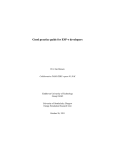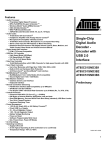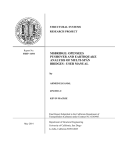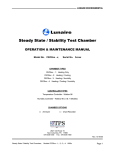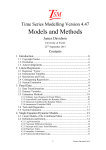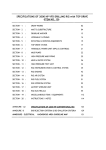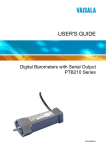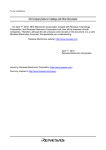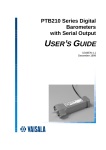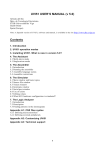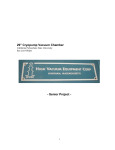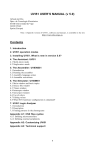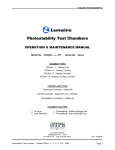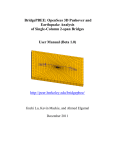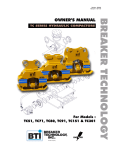Download 80S32 Radiation Report - ESA Microelectronics Section
Transcript
'Validation of 80S32 Microcontroller' SEU Radiation Test Report Owner Document Name Kostas Makris, Efstratios Politis, Tasos Lampaounas Revision 1.3 E-mail [email protected] [email protected] [email protected] Filename ISD_80S32_radiation_report_v 1.3-1.odt Division ISD Total pages 59 Site Athens, Crete Last modified 29 April 2009 Abstract This document presents information and the radiation results of the Single Event Upset (SEU) testing performed on an 80S32 microcontroller device at ESA/ESTEC Cf-252 radiation facilities. Company Confidential Page 1 of 59 'Validation of 80S32 Microcontroller' SEU Radiation Test ReportRev. 1.3 This page has been intentionally left blank Company Confidential Page 2 of 59 'Validation of 80S32 Microcontroller' SEU Radiation Test ReportRev. 1.3 Table of Contents 1 Revision History...................................................................................................................................................5 2 General Information.............................................................................................................................................6 2.1 Scope............................................................................................................................................................6 2.2 Applicable documents – References.............................................................................................................6 2.3 Definition of terms..........................................................................................................................................7 2.4 List of acronyms............................................................................................................................................7 2.5 People Involved.............................................................................................................................................7 3 Test component details.......................................................................................................................................8 4 Test setup.............................................................................................................................................................9 4.1 Radiation test facility......................................................................................................................................9 4.2 Test conditions............................................................................................................................................11 4.2.1 Temperature and Humidity.............................................................................................................11 4.2.2 Lighting...........................................................................................................................................11 4.2.3 Vacuum..........................................................................................................................................11 4.2.4 DUT values.....................................................................................................................................11 4.3 Component preparation...............................................................................................................................12 4.4 Test setup....................................................................................................................................................12 4.4.1 Test board .....................................................................................................................................13 4.4.2 Remote keypad...............................................................................................................................13 4.4.3 Test harness...................................................................................................................................14 4.5 Data logging, programming and monitoring equipment...............................................................................14 4.6 FPGA H/W...................................................................................................................................................15 5 Test Software Description.................................................................................................................................16 5.1 General Information.....................................................................................................................................16 5.2 Memory Test...............................................................................................................................................16 5.3 5.2.1 Brief Description.............................................................................................................................16 5.2.2 Detailed Description........................................................................................................................16 Memory & Arithmetic Test ........................................................................................................................16 5.3.1 Brief Description.............................................................................................................................16 5.3.2 Detailed Description........................................................................................................................16 6 Analysis Software Description..........................................................................................................................18 6.1 memonly......................................................................................................................................................18 6.2 mem_math..................................................................................................................................................18 7 Radiation procedure with SEU monitoring......................................................................................................20 7.1 1st run.........................................................................................................................................................20 7.2 2nd run........................................................................................................................................................21 7.3 ISD S.A. Responsibilities.............................................................................................................................21 7.4 ESTEC CASE responsibilities.....................................................................................................................21 8 Test Results........................................................................................................................................................22 8.1 Summary of test results...............................................................................................................................22 8.2 Upset rate....................................................................................................................................................22 Company Confidential Page 3 of 59 'Validation of 80S32 Microcontroller' SEU Radiation Test ReportRev. 1.3 8.3 8.4 8.2.1 1st Run...........................................................................................................................................22 8.2.2 2nd Run..........................................................................................................................................23 Crosssection .............................................................................................................................................23 8.3.1 Test crosssection...........................................................................................................................23 8.3.2 Crosssection per bit.......................................................................................................................23 8.3.3 Comparison with ASIC vendorprovided crosssections.................................................................24 Detailed test results.....................................................................................................................................26 8.4.1 1st Run – Memory Test...................................................................................................................26 8.4.2 2nd Run – Memory & Arithmetic Test.............................................................................................28 9 Conclusions.......................................................................................................................................................31 9.1 Suggestions for future developments .........................................................................................................31 10 APPENDIX A – Test component photographs.................................................................................................32 11 APPENDIX B – Test setup photographs...........................................................................................................34 12 APPENDIX C – Details of all radiation runs.....................................................................................................37 12.1 1st Run – Memory Test...............................................................................................................................37 12.2 2nd Run – Memory & Arithmetic Test..........................................................................................................37 13 APPENDIX D – Memory Test source code.......................................................................................................40 14 APPENDIX E – Memory + Arithmetic source code..........................................................................................47 List of Figures Figure 4.1: Cf252 Energy distribution.........................................................................................................................9 Figure 4.2: Cf252 Energy distribution.........................................................................................................................9 Figure 4.3: Cf252 LET distribution of fission products................................................................................................9 Figure 4.4: CASE radiation facility.............................................................................................................................10 Figure 4.5: The baseplate used for the tests. External diameter is shown................................................................10 Figure 4.6: Test setup block diagram........................................................................................................................12 Figure 8.1: Crosssection per bit vs LET (Atmel).......................................................................................................24 Figure 8.2 Errors Running Total for MemoryTest...................................................................................................26 Figure 8.3: Errors per time interval for MemoryTest (time interval = 1hour)...........................................................26 Figure 8.4 Detected errors running total for the Memory & Arithmetic test..............................................................29 Figure 8.5: Detected errors per time interval for the Memory & Arithmetic test (time interval = 1hour)....................29 Figure 10.1: 80S32 DUT lidded and top marking......................................................................................................31 Figure 10.2: 80S32 DUT delidded showing the exposed die inside the cavity.........................................................31 Figure 10.3: 80S32 DUT inside the socket of the test board.....................................................................................32 Figure 11.1: Test board inside the chamber. Belljar and implosion guard in place....................................................33 Figure 11.2: Cable details showing the vacuum release valve (yellow knob)............................................................33 Figure 11.3: Test board on the baseplate. Source holder not in place......................................................................34 Figure 11.4: Details of the test board showing the rubber feet and the IDC connectors............................................34 Figure 11.5: General arrangement of the test setup..................................................................................................35 Company Confidential Page 4 of 59 'Validation of 80S32 Microcontroller' SEU Radiation Test ReportRev. 1.3 List of Tables Table 3.1: Details of the component used for testing...................................................................................................8 Table 4.1: key parameter values for the DUT............................................................................................................11 Table 4.2: Summary of signals passing through the test harness.............................................................................14 Table 6.1: Log files and associated parser application..............................................................................................18 Table 6.2: Example of output files.............................................................................................................................19 Table 7.1: Durations and test/analysis software for each run....................................................................................20 Table 8.1: Summary of test results............................................................................................................................22 Company Confidential Page 5 of 59 'Validation of 80S32 Microcontroller' SEU Radiation Test ReportRev. 1.3 1 Revision History Revision History Date Revision Author Modification description 05/02/2009 1.0 K. Makris, E.Politis, T.Lampaounas Creation 03/03/2009 1.1 K.Makris, E.Politis, T.Lampaounas Updates: §2.1, §2.2, §4.2.1, §4.2.3, §4.4.1, §5.2.2, §5.3.2, Chapter 6, Table 7.1, §7.1, Table 8.1, §8.2, §8.3, §8.4 Additions: Table 6.1, Table 6.2, Chapter 9, APPENDIX D, APPENDIX E. 10/03/2009 1.2 K.Makris, E.Politis, T.Lampaounas Updates: sections: 5.2.1, 5.2.2, 5.3.1, 8.3.2, equation (5) on pg.24. 29/04/2009 1.3 K.Makris, E.Politis, T.Lampaounas Additions: section 8.3.3 Updates: chapter 9 Company Confidential Page 6 of 59 'Validation of 80S32 Microcontroller' SEU Radiation Test ReportRev. 1.3 2 General Information 2.1 Scope General Information This document presents the results of Single Event Upset (SEU) testing performed on a single 80S32 component using the ESA Californium252 Assessment for Single event Effects (CASE) facility at ESTEC in Noordwijk, The Netherlands. Information regarding the test setup and its installation in CASE facility are also reported. The results include the number of detected errors induced by radiation effects on the correct execution of special test programs, the exact time of occurrence during the runs and the number of successfully corrected (recovered) errors. The main purpose of the testing was to perform a preliminary characterization (pretesting) of the device in terms of sensitivity to radiation effects under specific operating conditions. This preliminary characterization was focused on evaluating the radiation performance of various structural blocks of the DUT, particularly the internal memory blocks, the logic elements and the EDAC algorithm. The characterization strategy was based on counting all the accumulated errors detected by the internal EDAC mechanism during the execution of special routines which were able to distinguish between corrected (recovered) and uncorrected (nonrecovered) errors. Any abnormal behavior or anomaly was monitored and logged. The goal of testing was the acquisition of sufficient amount of data during the runs which is presented in this document. The characterization of the DUT in terms of SEU sensitivity will be completed after postprocessing and interpreting the statistical sample collected during the tests. The report begins by providing information about the device selected to perform the tests. Then, details are provided both for the test setup and for the software used for testing and analysis. The results of all test runs are reported along with their corresponding graphs. Calculations of characteristic parameters such as the error rate, test cross-section and cross-section per bit of the test runs are also reported. Representative photographs of both the component and the test setup along with the details of all radiation runs are included on separate Appendices of this report. 2.2 Applicable documents – References [1] ESCC basic specification No. 25100, 'Single Event Effects Test Methods and Guidelines', Issue 1, October 2002. [2] ESA Statement Of Work, 'Validation of the ADV80S32 Microcontroller', Issue 0, Revision 0, May 2007. [3] Work Package 2, D2.1/D2.2, 'Validation Board Specifications and FPGA selection',ISD S.A. [4] “ ADV80S32 microcontroller", component datasheet, ADV Engineering, May 2001, V2.5. [5] “80S32 Evaluation Board User Manual”, ISD S.A. [6] https://escies.org, CASE System specifications. [7] http://www.atmel.com/dyn/resources/prod_documents/doc4172.pdf “Aerospace Products Radiation Test Result Summary”, Atmel. [8] ESA-QEC-ISO-CAS-007-09, “Procedure for Single Event Upset Pre-testing Using the CASE facility”, edt. Draft 1.5, ESTEC, January 2009. Company Confidential Page 7 of 59 'Validation of 80S32 Microcontroller' SEU Radiation Test ReportRev. 1.3 2.3 General Information Definition of terms The following definitions are stated on [1] and presented here as a reference. Single Event Upset (SEU) SEU is also known as a soft error. The change of state of a latched logic state from one to zero or viceversa. A single event upset is nondestructive and the logic element can be rewritten or reset. Linear Energy Transfer (LET) or Stopping power The amount of energy deposited per unit length along the path of the incident ion. It is expressed in units of MeV/mg/cm2, which is the energy per unit length divided by the density of the irradiated medium. The total duration of the radiation campaign was three days. It started on 12th of January and ended on 14th of January 2009. For convenience, each date of the test will be mentioned as follows: 2.4 2.5 ● Day1: Monday, 12th of January 2009 ● Day2: Tuesday, 13th of January 2009 ● Day3: Wednesday 14th of January 2009 List of acronyms DUT Device Under Test EDAC Error Detection And Correction FPGA Field Programmable Gate Array JTAG Joint Test Action Group LET Linear Energy Transfer PCB Printed Circuit Board SEE Single Event Effect SEU Single Event Upset UART Universal Asynchronous Receiver/Transmitter USART Universal Synchronous - Asynchronous Receiver/Transmitter ZIF Zero Insertion Force People Involved Name Location Email address Tasos Lampaounas ISD, Athens [email protected] Efstratios Politis ISD, Crete [email protected] Kostas Makris ISD, Athens [email protected] Company Confidential Page 8 of 59 'Validation of 80S32 Microcontroller' SEU Radiation Test ReportRev. 1.3 Company Confidential General Information Page 9 of 59 'Validation of 80S32 Microcontroller' SEU Radiation Test ReportRev. 1.3 3 Test component details Test component details The SEU testing was performed using only one device from the inventory of available samples. The total number of available samples was eight (8) and they were all supplied by ESA-ESTEC. From the total number of available samples, three (3) of them were delivered to ISD S.A at a previous date. Those three components were serialized by ESTEC prior to delivery with serial numbers (S/N): S/N#3, S/N#4 and S/N#5 respectively. The rest of the available samples (5) remained at ESA-ESTEC. In the scope of testing, ISD S.A. has equipped the test setup with the devices S/N#3 and S/N#5 but neither of these two components were eventually used to perform the test. The test was carried out using a component supplied by the stock of ESA-ESTEC. It should be noted that there was no particular restriction on selecting the component to execute the test. Table 3.1 shows the details of the selected component. Photographs of the actual part depicting the complete top marking and the die orientation inside the cavity are included in Appendix A. The internal architecture, functionality and pin list of the component are covered in detail in [4]. Part type ADV80S32 Part description 8-bit microcontroller Package type 100 LEAD MQFP ceramic with goldplated leads. Available samples 8 Top marking of the DUT 5962-00B0202V8C FMAADV80S32 0148-FR37586L Table 3.1: Details of the component used for testing. ESA-ESTEC recommended that the component used for testing should be reused as a DUT component, if any further radiation characterization tests are to be scheduled in the future. For this reason and to avoid any logistics-inventory problems, the component with S/N#5 was exchanged with the component of Table 3.1 by the end of this radiation campaign. Company Confidential Page 10 of 59 'Validation of 80S32 Microcontroller' SEU Radiation Test ReportRev. 1.3 4 Test setup Test setup This paragraph contains information about the radiation test facility and the actual setup used to perform the radiation tests. 4.1 Radiation test facility The test facility used for the campaign was the ESA Californium-252 Assessment of Single-event Effects (CASE) facility at ESTEC, The Netherlands. The CASE system uses a 1 to 3 microcurie Cf-252 source which is safe to handle in the laboratory, provided that the normal precautions for the handling of radioactive sources are observed. The spontaneous fission of Californium-252, which has an effective half-life of 2.65 years, produces a wide range of high-energy particles having an average LET of 43 MeV/(mg/cm2). Cf-252 produces an average of 3.7 neutrons per fission with an average energy of 2.3MeV [6]. The Cf-252 source used in the test had an activity of 1.23uCi with a standard uncertainty of ±30%. The following diagrams are from [6] and presented here as a reference. Figure 4.1: Cf252 Energy distribution Figure 4.3: Cf252 LET distribution of fission products Figure 4.2: Cf252 Energy distribution The DUT chamber consists of a dome-shaped bell-jar made of glass, lying on top of a 400mm X 400mm metal base plate. The bell-jar has an internal diameter of 270mm, height of 250mm plus a 100mm radius dome (Figure 4.4). The baseplate includes a variety of feedthrough connectors for electrical connections. The Cf-252 source is placed on metal holder, which can move freely up and down with a help of rod for height adjustments above the DUT. The DUT test board is placed inside the chamber and stands freely on the baseplate, while the source holder is aligned directly above the DUT. The air inside the chamber is pumped out using a vacuum pump via a special port on the baseplate. The value of the vacuum is monitored in real time via a meter located near the chamber. The CASE system may use a variety of baseplates with the differentiating factor to be the number and type of the feedthough connectors. The baseplate used in the test is illustrated in Figure 4.5. During all tests, an aluminium screened implosion guard was placed around the belljar to protect the DUT against sensitivity to light and electromagnetic interference. Company Confidential Page 11 of 59 'Validation of 80S32 Microcontroller' SEU Radiation Test ReportRev. 1.3 Implosion guard (aluminum screening not shown) Test setup Belljar Source holder rod Baseplate Vacuum meter Lab benchtop Figure 4.4: CASE radiation facility Figure 4.5: The baseplate used for the tests. External diameter is shown. Company Confidential Page 12 of 59 'Validation of 80S32 Microcontroller' SEU Radiation Test ReportRev. 1.3 4.2 Test setup Test conditions This paragraph provides information about key parameters of the test. 4.2.1 Temperature and Humidity Air-conditioning in the laboratory which hosts the CASE facility maintains a temperature of 22º C ± 2º C with a humidity level of 40% ±10% [8]. Since the DUT operated under vacuum conditions there was no possibility for cooling the chip using natural convection. Due to the lack of any alternative cooling mechanism, the DUT temperature is expected to be higher than the ambient temperature. However, there was no provision for measuring the temperature of the chip separately during the runs, so a specific value cannot be reported. 4.2.2 Lighting As mentioned in section 4.1 an aluminum screened implosion guard was used around the belljar, to protect the DUT from ambient lighting. Thus, during all tests the vacuum chamber area remained darkened. 4.2.3 Vacuum The target operating vacuum value inside the chamber was 10 -2 mbar1, although this condition was never reached during the tests. The actual vacuum reading on all tests was stabilized on 2X10-2 mbar and this was eventually achieved after approximately 5 hours of pumping. It should be noted that the vacuum pump was operating continuously during the tests and was switched on at the beginning of each test. A vacuum of 6X10-2 mbar was established after approximately 2 hours. 4.2.4 DUT values Table 4.1 specifies the values of key parameters for the DUT. The baud rate is referred to the value selected for the UART port of the test setup. Parameter Value Core voltage-source +5.15VDC regulated supply using the on board regulator LMS1585 [3]. I/O voltage-source +5.15VDC regulated supply using the on board regulator LMS1585 (the same source as the core supply) [3]. Clock frequency 22 MHz Clock source FPGA device of the test-board [3]. UART Baud rate 9600 bps, no parity Table 4.1: key parameter values for the DUT. 1 mbar x 100 = Pascal Company Confidential Page 13 of 59 'Validation of 80S32 Microcontroller' SEU Radiation Test ReportRev. 1.3 4.3 Test setup Component preparation Since the penetration depth of the fission fragments of the Cf-252 source is only a few tens of microns and in order to increase the fission product influence at the DUT, the device itself needs to be delidded (decapsullated) to expose the die surface. From the total number of available samples three devices were de-lidded. The first device was decapsulated 1 month before carrying out the test in ESA-ESTEC laboratories, in order to determine the difficulty of the de-lidding process. Two more devices were successfully de-lidded in ESA-ESTEC laboratories during day-1 of the radiation campaign in order to have spare devices available for the tests (backup). From the new devices that were de-lidded, the first was the sample S/N#5 while the second was the component which eventually used to perform the tests (Table 3.1). Before de-lidding, the selected DUT component (Table 3.1) was subject to some basic functional tests by executing the “Instruction Set” & “Performance” tests under normal ambient conditions (atmospheric pressure, no radiation exposure) to check the correct operation. After the de-lidding operation, the particular component was subject again to the same functional tests to determine if any damage occurred during the de-lidding procedure. These tests did not only verified the correct operation of the DUT component, but also the functionality of the test board and the overall setup. Both the DUT component and the test board were exhibited the expected behavior. Photographs of both lidded and de-lidded DUT component are shown in Appendix A. 4.4 Test setup The test setup of the radiation campaign is graphically represented in Figure 4.6. Company Confidential Page 14 of 59 'Validation of 80S32 Microcontroller' SEU Radiation Test ReportRev. 1.3 Test setup Belljar Vacuum meter Vacuum pump B Host PC USB Byte blasterTM D DUT JTAG A C DUT board Motherboard RS-232 +8VDC Power supply Flash memory programmer Laptop CASE Baseplate +8VDC Remote keypad Feedthrough connectors Figure 4.6: Test setup block diagram. The hardware setup provided by ISD S.A. consisted of the following major parts: 4.4.1 ● test board with external power supply ● remote keypad ● test harness (cabling) ● host PC with ALTERA® ByteBlasterTM ● laptop PC with external flash memory programmer. Test board The test board (validation board) consists of a motherboard and a daughterboard PCB (DUT board). The daughterboard contains the socket, which hosts the DUT and is placed on top of the motherboard in a 'stacked' arrangement. The exposed die of the DUT is directly accessible from the radioactive source via an opening on the top side of the socket. The motherboard includes an FPGA device, memory devices, the power supply and various I/O interfaces. The technical specifications of the test board (also referred to as validation board) are presented with details in [3]. The user manual of the test board is given on [5], including a detailed description of the connectivity between the different elements of the test setup as well. Since the CASE baseplate does not provide a specific mounting option for the test board, the latter was placed on the baseplate using a set of M3 brass spacers, mounted on the 4 corners of the motherboard. In order to prevent the motherboard from skewing from its original position during positioning of the belljar, the brass spacers were terminated on rubber feet for increased friction. The clearance between the baseplate and the bottom side of motherboard PCB was set to 58mm in order Company Confidential Page 15 of 59 'Validation of 80S32 Microcontroller' SEU Radiation Test ReportRev. 1.3 Test setup to allow the cables to run and lie comfortably underside. The final position of the the test board was chosen properly so as the central point of the source holder to lie directly above the center of the exposed die. This optical alignment was performed manually. The height of the source holder was adjusted on the vertical rod in order the distance between the source holder and the top side of the DUT socket to be approximately 1mm. The overall distance between the source holder and the die surface was 10 mm. The complete system (motherboard plus the DUT board) was able to fit properly inside the belljar and the cabling was found to be compatible. In general, no hardware problem was encountered. The DUT was powered exclusively from the motherboard via the appropriate on-board regulators (see [3] for more details). The board was powered by an external +8VDC/1A power supply mounted on a wall power outlet of the lab. Via a switch it was possible to turn on and off the power supply from outside the belljar. Photographs of the installed test board inside the CASE system are shown in Appendix B. 4.4.2 Remote keypad A remote keypad located outside the vacuum chamber permitted remote communication with the test board during the runs. The remote keypad is shown in the test setup photographs in Appendix B and is described in more detail in [5]. Via the remote keypad it was possible to perform the following operations: ● selection between the RESET and RUN mode of the DUT by toggling the key #1 on the keypad. ● optical indication of the above current status on the LCD. ● Variation of UART baud rate by selecting among others from a list (Table 4.1). ● Via a H/W that was developed during day2 of the radiation campaign, display of the following values in Hex format: 4.4.3 ○ number of corrected errors ○ number of uncorrected errors ○ the memory address on which the last error has occurred ○ number of arithmetic errors Test harness The term test harness is used to describe all the feedthrough cables that were utilized to interface the test board with the rest of the equipment located outside the vacuum chamber. The test harness consists of 2 sets of ribbon cables (4 ribbon cables in total), indicated with the letters A-D and shown with thick lines on Figure 4.6. The thick dotted line depict the ribbon cables connecting the connectors inside and outside the chamber on the baseplate. The first set (A,B) is used to connect the equipment (host PC, power supply, etc.) with the connectors outside the chamber, while the second set (C,D) to connect the test board with the connectors lying inside the chamber. The ribbon cables at one end were terminated in 40 pin female IDC connectors in order to mate properly with the IDC sockets available on the baseplate. On the other end they were terminated in connectors suitable to mate with the headers of the test board and the equipment outside the chamber. In summary, the signal types passing through each cable are shown in Table 4.2 below. The technical details of the test harness along with the relevant pin lists are covered in [5]. Company Confidential Page 16 of 59 'Validation of 80S32 Microcontroller' SEU Radiation Test ReportRev. 1.3 Cable reference designator Test setup Signals passing through A,C Remote keypad B,D JTAG for the FPGA, 2 X UARTS (RS-232), 5 X USARTS, +8VDC, access to current sense resistors for power measurements on VCCA, VCCB power planes of the DUT. Table 4.2: Summary of signals passing through the test harness. Although the frequency of the signals passing through the cables is not too high, the length of each cable was carefully selected and kept to a minimum in order to maintain the signal integrity to maximum extend. 4.5 Data logging, programming and monitoring equipment The test progress was monitored and logged through an external application (HyperTerminal) executing on a WindowsTM host PC, connected to the validation board over an RS-232 link, as shown in Figure 4.6. A '.txt.' log file was generated for each test run and stored in the PC. Via the same PC it was possible to download a different configuration file to the FPGA without removing the belljar. FPGA configuration was performed using a JTAG interface, via an ALTERA® ByteBlasterTM USB programmer and the relevant application (QuartusTM). The programs targeting the DUT were written in the Flash-memory (AMIC2904) located on motherboard [3], using a universal external programmer from DATAMAN®, which was connected via a USB port with an auxiliary laptop PC. When the program of the DUT needed to be changed (e.g. between the tests, or during other functional tests), the belljar needed to be opened, the flash memory was removed from its ZIF socket on the motherboard and placed on the external programmer. After programming, the memory device was replaced in its socket on the motherboard. Company Confidential Page 17 of 59 'Validation of 80S32 Microcontroller' SEU Radiation Test ReportRev. 1.3 4.6 Test setup FPGA H/W The main purpose of the core hardware implemented inside the FPGA was the proper routing of the signals between the DUT and the peripheral devices (RS-232 transceivers, memories, remote keypad, etc.). In order to improve the monitoring and logging features of the DUT during the 2 nd test run and as a backup to the existing setup, it was decided to replicate into the FPGA the counters maintained in memory, and to be triggered by the test whenever the corresponding internal counter was incremented. Three counters along with the necessary logic were implemented inside the FPGA. The first two have been used for counting the memory corrected and uncorrected errors, whereas the third one has been used to count the number of arithmetic errors. Additionally, it was decided to store the memory address where the last event occurred in a register and display it on the LCD along with the counters, as mentioned in section 4.4.2. A watchdog timer in the FPGA that upon expiration would reset the uC was also under consideration for implementation. The watchdog would be reset at regular time intervals by the test software. Given the time restrictions this feature was not implemented. All the additional HW was developed during day-2. Company Confidential Page 18 of 59 'Validation of 80S32 Microcontroller' SEU Radiation Test ReportRev. 1.3 5 Test Software Description 5.1 General Information Test Software Description Two test applications were developed using KEIL μVision3 v3.60 IDE. Both applications were implemented in assembly language due to the erroneous behavior when compiled directly from C code. Specifically, when the EDAC feature on internal memory is enabled, some variables counters keeping track of detected errors are affected and have their value inadvertently changed. This is obviously a case of memory access violation, most likely attributed to the precompiled libraries that are automatically linked into the executable. 5.2 Memory Test 5.2.1 Brief Description The memory test initializes an array of 50 bytes in internal memory and another one of 50 bytes in XRAM. The value of each element in either array is its index itself. An interrupt routine for interrupt INMEMER is installed to count and correct detected errors. Both arrays are accessed sequentially in order to trigger the EDAC. Once all elements of both arrays have been accessed, the number of detected errors is sent through the UART and the test is repeated infinitely. 5.2.2 Detailed Description The test setsup parallel ports P1,P2 and P3 which are used for output with the exception of pins P3.0 and P3.1 that are reserved for the UART interface which is clocked at 9600 baud by Timer2. Both EDAC and XRAM are enabled and then an array of 50 bytes in internal memory and another one of 50 bytes in XRAM are initialized, where the value of each element in either array is its index. Four bytes are reserved in the internal memory to implement the two error detection counters (2 bytes each). These counters are incremented by an interrupt routine triggered by the interrupt INMEMER. The handler will increment one of the two counters depending on whether the error is flagged as recoverable or not and then it will reset register MPSTAT. If the error is recoverable, a pulse is created on P3.2 while P1 contains the address at which the error was detected. If the error is unrecoverable a pulse is created on P3.3. If the interrupt handler is invoked and MPSTAT indicates no error, the handler exits without affecting the counters or creating a pulse on the pins of P3. The main loop of the application consists of sequentially accessing of all elements in both arrays followed by sending through the UART the values of the counters in hexadecimal and then incrementing P2 to indicate that the test is functioning as expected. The total amount of exercised memory is 50 bytes of XRAM and 63 bytes of internal memory of which 4 bytes are used by the general purpose registers, 5 by the stack, 2 bytes each of the two counters and 50 bytes for the array. The size of the array in the internal memory could be increased, provided that sufficient space is reserved for the stack so that it doesn't grow into the EDAC. For the initial test run it was decided to be set at a conservative 50bytes. For the source code of the test please see Appendix D. The complete project may be extracted from file seu_mem_only.zip. 5.3 5.3.1 Memory & Arithmetic Test Brief Description This test extends the memory test with the inclusion of 8bit arithmetic operations such as addition, multiplication and increment. 128 bytes, instead of 50. For the arithmetic operations, the calculated Company Confidential Page 19 of 59 'Validation of 80S32 Microcontroller' SEU Radiation Test ReportRev. 1.3 Test Software Description values are compared against the expected values, which are hardcoded into the test program. Detected errors are accumulated in a counter whose value is sent through the UART along with the values of the memory related counters. 5.3.2 Detailed Description The arithmetic test is focused on 8bit integer arithmetic because it is directly supported by the hardware, whereas 16bit, 32bit or floating number arithmetic would require a software implementation of the arithmetic operators. First we count from 0 up to 99 by incrementing a counter and comparing its value against the value of the accumulator, which has been loaded from code memory. The loop is controlled by another counter decremented to 0. Then the addition procedure is checked by adding the values of two registers and comparing against a fixed value. The first register is initialized to 0x00 and the other to 0xFF. At each iterations the former is incremented whereas the later is decremented. Finally, the multiplication is checked by calculating the squares of the first 20 number. At each iteration the same value is loaded in both A and B registers and the result of the multiplication is checked against hardcoded values stored in two arrays one for each register. In all cases, if the obtained value is not equal to the expected one, the error counter is incremented by one. The total amount of exercised memory is 128bytes of XRAM and 62 bytes of Internal memory of which 4 bytes are used by the general purpose registers, 5 by the stack, 1 byte each of the three counters and 50 bytes for the array. For the source code of the test please see Appendix E. The complete project may be extracted from file seu_mem+math.zip. Company Confidential Page 20 of 59 'Validation of 80S32 Microcontroller' SEU Radiation Test ReportRev. 1.3 6 Analysis Software Description Analysis Software Description Due to the simplicity of the logging strategy, large log files are produced even for relatively small runs, thus requiring a parser to process the data. Since each test produces a unique output and in order to keep the application simple, two command line applications were built each one specific to a single test. The two applications have been compiled with gcc v4.1.2 on CentOS 5. The source code (in C) of the two parsers and the logs are supplied in separate files under the following names (Table 6.1): Parser Log File Description memonly.c monday_12_01_2009.txt First run mem_math.c tuesday_13_01_2009.txt Second run Table 6.1: Log files and associated parser application. 6.1 memonly This application is for parsing the log files produced by the 'Memory' test. It accepts as input the name of the log file and outputs a file named after the logfile and extended with the string “results.txt”. The application processes the logfile a line at a time. From each line we extract the value of the recoverable and unrecoverable error counters. If the counter changes value, the line number is used to estimate the time that the event took place. Both line number and timestamp along with the counters are recorded. If a counter is decremented, it is considered as an upset. Lines that do not match the expected format are ignored and are reported as anomalies into the output file. 6.2 mem_math This application is for parsing the log files produced by the 'Memory & Arithmetic Test” and is similar in operation to the memonly application. It accepts as input the name of the log file and outputs a file named after the logfile and extended with the string “results.txt”. It will also produce a file with the extension “anomalies.txt” containing only the timestamps of occurred anomalies and a file with the extension “seu.txt” containing only timestamps and the value of counters in a simplified form. These two files are meant to be used for chart plotting thus they are devoid of any formatting unlike the results file. The application processes the logfile a line at a time. From each line we extract the value of the recoverable, unrecoverable and arithmetic error counters. If a counter changes value the line number is used to estimated the time the event took place. Both line number and timestamp along with the counters are recorded. If a counter is decremented, is considered as an upset. Lines that do not match the expected format are ignored and are reported as anomalies into the output file. In order to guard against false upsets, the application also accepts an optional parameter indicating the bitflip threshold below which a negative value change is ignored, provided that the low value appears right after the high value. If the parameter is not supplied the threshold is assumed to be 0, i.e. every change is recorded. Company Confidential Page 21 of 59 'Validation of 80S32 Microcontroller' SEU Radiation Test ReportRev. 1.3 Analysis Software Description The value of the threshold is used in the naming of the output files by prefixing the filetype identification strings. For a log file named “tuesday_13_01_2009.txt” the following output is produced (Table 6.2) : File Type Threshold = 0 (Default) Threshold = 1 results tuesday_13_01_20090results.txt tuesday_13_01_20091results.txt anomalies tuesday_13_01_20090anomalies.txt tuesday_13_01_20091anomalies.txt seu tuesday_13_01_20090seu.txt tuesday_13_01_20091seu.txt Table 6.2: Example of output files. Company Confidential Page 22 of 59 'Validation of 80S32 Microcontroller' SEU Radiation Test ReportRev. 1.3 7 Radiation procedure with SEU monitoring Radiation procedure with SEU monitoring The total duration of the Cf-252 radiation campaign was three days: ● Day1: Monday, 12th of January 2009 ● Day2: Tuesday, 13th of January 2009 ● Day3: Wednesday,14th of January 2009 During that period two overnight SEU radiation runs (test runs) were performed and the results of each test were logged onto separate files on the host PC via the HyperTerminal application. The following table summarizes the information regarding each test run. Date/time started Date/time terminated Total duration Test program Analysis program 1st RUN Day-1/14:00(1) Day-2/09:15(1) 19h 15m(2) (12h) Memory Test memonly 2nd RUN Day-2/19:25 Memory & arithmetic test mem_math Day-3/14:56 19h 31m Table 7.1: Durations and test/analysis software for each run. More details regarding each test run are presented in the following sections. Notes: 1. The indicated time figures correspond to the start-stop times of the uC. 2. The time duration is referring to the total duration of the particular test run. It should be noted that the time duration of the uC producing legible data was approximately 12h (see §8.4.1). 7.1 1st run The first test initiated on day1 at 14:00 (powerup) and terminated on day2 at 09:15 (powerdown). The first test involved testing the EDAC capability with respect to the internal memory (imem) and XRAM using the 'Memory Test' software (§5.2) . Using the 'memonly' application (§6.1), the analyzed data were sent over the UART interface to the external application (HyperTerminal) for logging into a file. On day2, 08:50 it was discovered that the HyperTerminal had stopped receiving data, although the uC was still transmitting. Transmission was confirmed by monitoring the RS232 traffic through another application. This application showed that the uC was producing a repetitive pattern of characters, though carrying no resemblance to the output format coded in the test software. Based on the size of the logfile it was estimated that HyperTerminal had ceased logging early in the morning of day2. This estimate was later confirmed by the logfile analysis (see §8.4.1). Given time restrictions, it was decided the next test run to be focused on running a single test for a long enough period to collect sufficient statistical data, rather than attempt to exercise many features by running multiple tests. In order to improve the logging capability of the test setup, it was decided to Company Confidential Page 23 of 59 'Validation of 80S32 Microcontroller' SEU Radiation Test ReportRev. 1.3 Radiation procedure with SEU monitoring add some extra logging features into the FPGA, as described in § 4.6. 7.2 2nd run The belljar was opened, the onboard flash memory was removed, reprogrammed and replaced inside the socket on the motherboard. The second test initiated on day2 at 19:25 and terminated on day3 at 14:56, about 19.5 hours. The second test involved testing the EDAC capability with respect to the internal memory (imem) and XRAM plus arithmetic operations in 8bit arithmetic using the 'Memory & Arithmetic Test' software (§5.3). Using the 'mem_math' application (§6.2), the results of program execution were delivered into a PC via the RS232 port and logged in a new file. At 09:50 local time it was observed that the internal counter was reset to 0 whereas the counter on the FPGA indicated 36 errors. Since the test carriedon, it was assumed that the instruction sequence had been altered by jumping back at some point before the reset of the counters, either because the PC, or the instruction fetch or instruction decode unit had been affected. It is unlikely for the uC to have been reset because the start message sent at the beginning of the test was not found in the logfile around the time the event took place. 7.3 ISD S.A. Responsibilities ISD S.A. was responsible for supplying the test board, compatible cables to interface with the CASE system (test harness), power supplies and the monitoring, programming and logging equipment for the experiments. ISD S.A was also responsible for assembling and mounting up the equipment and for performing the actual testing and log the results. 7.4 ESTEC CASE responsibilities A qualified operator from ESTEC handled the radioactive material, sealed the vacuum chamber by placing both the belljar and the implosion guard above the baseplate and started the vacuum pump. After each radiation run had been terminated, he restored the atmospheric pressure inside the chamber by releasing the valve, removed the belljar-implosion guard and placed the radioactive source in a safe location. Company Confidential Page 24 of 59 'Validation of 80S32 Microcontroller' SEU Radiation Test ReportRev. 1.3 8 Test Results Test Results Because of the various uncertainties in the basic activity, thickness of the gold layer over the radiation source, the distance and penetration depth to the DUT, ESA-ESTEC recommends that a flat uncertainty of ±42% to be applied to the SEU rate results obtained from the CASE facility [8]. This means that we cannot expect to know the source activity to better than 42%. In every case, it should be noted that the CASE facility can be considered as a pre-test for a Heavy Ion radiation campaign, as the results obtained here exhibit a significant uncertainty. 8.1 Summary of test results In both test runs only corrected errors have been detected (i.e. less than three bitflips) and no other errors have been indicated by either the FPGA or internal counters. Given the test conditions (vacuum, radiation source) and DUT technology (0.5um), the number and type of detected errors can be considered as both logical and expected. The two interrupts on software’s normal execution (crashes on both test runs) may be assumed to be SEU events in flipflops due to irradiation, as only a subset of the flipflops is SEU hardened. The test results for each radiation run are summarized in Table 8.1: 1st RUN 2nd RUN 12h 19h 31m Corrected RAM errors (e) 7 42 Uncorrected RAM errors 0 0 Possible flip-flop SEU events 1 1 Upset rate er (upsets/ sec) 1.62x10-4 5.98x10-4 Test cross-section X (cm2) 3.90x10-6 1.43x10-5 Cross-section per bit Xb (cm2/bit) 4.31x10-9 9.40x10-9 Total duration (t) Table 8.1: Summary of test results. 8.2 Upset rate This section presents the upset rate (error rate) calculations in upsets/sec for both test runs. 8.2.1 1st Run The duration of the run (as described in chapter 7) is about 12h. The test duration (t1) expressed in seconds is: t1 = 12 * 3600 sec = 43,200 sec Since there were no uncorrected RAM errors detected, the calculation takes into account the number of corrected errors. The total number of corrected RAM errors (upsets) e during the run was seven (e1 = 7) (Table 8.1). The upset rate (er1) is calculated by dividing the total number of upsets with the test duration , as shown in (1) Company Confidential Page 25 of 59 'Validation of 80S32 Microcontroller' SEU Radiation Test ReportRev. 1.3 er1 = 8.2.2 Test Results e1 7upsets = = 1.62 × 10 − 4 upsets / sec (1) t1 43,200 sec 2nd Run The duration of the run (as described in chapter 7) is about 19.5h. The test duration (t2) in seconds is: t2 = 19.5 * 3600 sec = 70,200 sec The total number of corrected RAM errors during the run was forty two (e2 = 42) (Table 8.1). The upset rate (er2) is calculated by dividing the total number of upsets with the test duration , as shown in (2) er 2 = 8.3 e2 42upsets = = 5.98 ×10 − 4 upsets / sec (2) t 2 70,200 sec Crosssection This section presents the cross-section calculations (in cm2) for both test runs. 8.3.1 Test crosssection The cross-section (X-section) is defined as the upset rate (er) divided by the flux (Φ) of the radiation source. The flux, among others, depends on the age of the radiation source [8]. As reported by ESA-ESTEC, the Cf-252 source used in both tests had a flux Φ of about 2500 particles/(cm² * min) - which is equivalent to 41.6 particles/(cm² * sec) - at a distance d of about 10mm between the source and the DUT die surface. Because d = 10mm during the tests, we can use the above flux figure in the calculations. The X-section X1 for the 1st run is calculated below (3): X1 = er1 1.62 × 10 −4 upsets / sec = = 3.90 ×10 −6 cm 2 (3) 2 Φ 41.6 particles /(cm ⋅ sec) X1 is the X-section of the DUT, exercised with the memory test program (see §5.2). The X-section X2 for the 2nd run is calculated below (4): X2 = er 2 5.98 × 10 −4 upsets / sec = = 1.43 ×10 −5 cm 2 (4) Φ 41.6 particles /(cm 2 ⋅ sec) X2 is the X-section of the DUT, exercised with the memory and arithmetic test program (see §5.3). 8.3.2 Crosssection per bit The X-section per bit Xb for a particular test is defined as the test X-section (X) divided by the total number of bits n covered during that test. The 1st run was performed using the memory test software which covers 63 bytes in internal memory plus 50 bytes in the XRAM. Thus the total number of bytes is 63+50=113bytes = 904bits = n1. The X-section per bit Xb1 for the 1st run is calculated below (5): Company Confidential Page 26 of 59 'Validation of 80S32 Microcontroller' SEU Radiation Test ReportRev. 1.3 X b1 = Test Results X 1 3.90 ×10 −6 cm 2 = = 4.31×10 −9 cm 2 / bit (5) n1 904bits The 2nd run was performed using the memory plus arithmetic test software which covers 62 bytes in internal memory plus 128 bytes in the XRAM. Thus the total number of bytes is 62+128=190bytes = 1520bits = n2. The X-section per bit Xb2 for the 2nd run is calculated below (6): X b2 = 8.3.3 X 2 1.43 ×10 −5 cm 2 = = 9.40 ×10 −9 cm 2 / bit (6) n2 1520bits Comparison with ASIC vendorprovided crosssections In [7], Atmel specifies the saturated cross-section of the MG2RT technology as 3 * 10-7 cm²/bit. This means that our experimental cross-sections are about 30 – 70 times lower than values provided by Atmel. The exact reasons could not be determined, but the following issues possibly contribute to the discrepancy: – There is an uncertainty (factor 2) on the true activity of the Californium source which depends on the age of the source. – With an average LET of Cf-252 of 43 MeV *cm² / mg, we do not fully reach the saturated cross-section (value of the horizontal asymptotic in the figure below). Experimental cross-sections observed during testing are lower than the saturated cross-sections obtained specified in the vendor documents. In addition, cross-sections obtained with Cf-252 are always a bit lower than cross-sections obtained in cyclotron heavy ion test. A possible reason for this is the insufficient penetration depth of the Cf-252 fission products. These effects can cumulate to a discrepancy of 30-40%. – The distance between source and die could not be exactly measured. Increasing from 1 cm to 1.4 cm reduces the flux at the die surface by a factor of 2. – Atmel figures are specified at Vcc = 4.5V. At 5V in our cases, the cross-section is reduced. Company Confidential Page 27 of 59 'Validation of 80S32 Microcontroller' SEU Radiation Test ReportRev. 1.3 Test Results Figure 8.1: Crosssection per bit vs LET (Atmel) 8.4 Detailed test results 8.4.1 1st Run – Memory Test The following is an extract of the results file produced by application memonly when passed the log file produced by the memory test on Monday 12/01/2009 (Day1). The effective duration of the test, within valid output data were collected, was about 12h (11h 48min). ================================================== Log filename: monday_12_01_2009 Number of Lines: 1800949 Estimating: 23.6 sec / 1000 iter Test Duration (hh:mm:ss): 11:48:22 -------------------------------------------------Recoverable Errors: 7 Un-Recoverable Errors: 0 Number of Upsets: 0 Number of anomalies: 236 -------------------------------------------------83823 (00:32:58), R=1 U=0 181053 (01:11:12), R=2 U=0 193245 (01:16:00), R=3 U=0 505782 (03:18:56), R=4 U=0 1166537 (07:38:50), R=5 U=0 1174788 (07:42:04), R=6 U=0 1622572 (10:38:12), R=7 U=0 ================================================== Company Confidential Page 28 of 59 'Validation of 80S32 Microcontroller' SEU Radiation Test ReportRev. 1.3 Test Results Error running total 8 7 6 4 3 2 1 0 0:00:00 2:24:00 4:48:00 Time Recoverable 7:12:00 9:36:00 12:00:00 Un-Recoverable Figure 8.2 Errors Running Total for MemoryTest Errors per Interval 2 1.8 1.6 1.4 1.2 Errors Errors 5 1 0.8 0.6 0.4 0.2 0 1 2 3 4 5 6 7 8 9 10 11 Interval Figure 8.3: Errors per time interval for MemoryTest (time interval = 1hour). Company Confidential Page 29 of 59 'Validation of 80S32 Microcontroller' SEU Radiation Test ReportRev. 1.3 8.4.2 Test Results 2nd Run – Memory & Arithmetic Test The following is an extract of the results file produced by application mem_math when passed the log file produced by the memory & arithmetic test on Tuesday 13/01/2009 (Day2). The arrows on the righthand side indicate the negative value changes after the elimination of singlebitflip changes in consecutive lines. Note that the remaining upsets are all singlebitflips furthermore all bitflips occurred at the second bit of the first ASCII character representing the value of the recoverable counter. Thus it is safe to ignore them when plotting charts (Figure 8.4 & Figure 8.5). The number of errors indicated in first part of the report, reflects the last legible counter values extracted from the logfile. These are not necessary the total number of errors (hence the second and more detailed part of the report) since that would require a more advanced parser. The number of upsets represents the negative transitions that have been detected, however not all marked because some might have been ignored depending on the threshold value. This information is presented at the end of the report. ================================================== Log filename: tuesday_13_01_2009 Number of Lines: 2124652 Estimating: 33.1 sec / 1000 iter Test Duration (hh:mm:ss): 19:32:05 -------------------------------------------------Recoverable Errors: 10 Un-Recoverable Errors: 0 Arithmetic Errors: 0 Number of Upsets: 17 Number of anomalies: 41 -------------------------------------------------1 (00:00:00) -> START 2 (00:00:00) -> R=1 U=0 M=0 218 (00:00:07) -> START 32830 (00:18:06) -> R=1 U=0 M=0 81195 (00:44:47) -> R=2 U=0 M=0 117040 (01:04:34) -> R=22 U=0 M=0 127538 (01:10:21) -> R=2 U=0 M=0 <<< 171221 (01:34:27) -> R=3 U=0 M=0 180269 (01:39:26) -> R=4 U=0 M=0 217002 (01:59:42) -> R=24 U=0 M=0 227495 (02:05:30) -> R=4 U=0 M=0 <<< 265717 (02:26:35) -> R=5 U=0 M=0 274632 (02:31:30) -> R=6 U=0 M=0 312439 (02:52:21) -> R=7 U=0 M=0 348005 (03:11:58) -> R=8 U=0 M=0 402899 (03:42:15) -> R=28 U=0 M=0 403793 (03:42:45) -> R=8 U=0 M=0 <<< 437946 (04:01:36) -> R=28 U=0 M=0 474216 (04:21:36) -> R=8 U=0 M=0 <<< 514238 (04:43:41) -> R=9 U=0 M=0 528607 (04:51:36) -> R=A U=0 M=0 549054 (05:02:53) -> R=B U=0 M=0 564656 (05:11:30) -> R=2B U=0 M=0 568020 (05:13:21) -> R=B U=0 M=0 <<< 629263 (05:47:08) -> R=C U=0 M=0 683495 (06:17:03) -> R=D U=0 M=0 Company Confidential Page 30 of 59 'Validation of 80S32 Microcontroller' SEU Radiation Test ReportRev. 1.3 Test Results 728499 (06:41:53) -> R=E U=0 M=0 783915 (07:12:27) -> R=F U=0 M=0 784655 (07:12:52) -> R=10 U=0 M=0 843583 (07:45:22) -> R=30 U=0 M=0 873492 (08:01:52) -> R=31 U=0 M=0 908260 (08:21:03) -> R=32 U=0 M=0 915522 (08:25:03) -> R=12 U=0 M=0 <<< 924409 (08:29:57) -> R=13 U=0 M=0 937872 (08:37:23) -> R=14 U=0 M=0 968757 (08:54:25) -> R=15 U=0 M=0 1006154 (09:15:03) -> R=16 U=0 M=0 1024008 (09:24:54) -> R=17 U=0 M=0 1044899 (09:36:26) -> R=18 U=0 M=0 1053067 (09:40:56) -> R=38 U=0 M=0 1072101 (09:51:26) -> R=39 U=0 M=0 1120464 (10:18:07) -> R=3A U=0 M=0 1126973 (10:21:42) -> R=3B U=0 M=0 1187655 (10:55:11) -> R=3C U=0 M=0 1217234 (11:11:30) -> R=1C U=0 M=0 <<< 1234175 (11:20:51) -> R=1D U=0 M=0 1375923 (12:39:03) -> R=1E U=0 M=0 1497509 (13:46:07) -> R=1F U=0 M=0 1503643 (13:49:30) -> R=20 U=0 M=0 1530344 (14:04:14) -> R=0 U=0 M=0 <<< 1581565 (14:32:29) -> R=1 U=0 M=0 1652205 (15:11:27) -> R=21 U=0 M=0 1677698 (15:25:31) -> R=1 U=0 M=0 <<< 1769761 (16:16:19) -> R=2 U=0 M=0 1826936 (16:47:51) -> R=3 U=0 M=0 1858032 (17:05:00) -> R=4 U=0 M=0 1907980 (17:32:34) -> R=5 U=0 M=0 1922822 (17:40:45) -> R=6 U=0 M=0 1936408 (17:48:15) -> R=7 U=0 M=0 1936884 (17:48:30) -> R=8 U=0 M=0 1959346 (18:00:54) -> R=28 U=0 M=0 1980433 (18:12:32) -> R=8 U=0 M=0 <<< 2016911 (18:32:39) -> R=9 U=0 M=0 2116312 (19:27:29) -> R=A U=0 M=0 -------------------------------------------------Max flipped bits per byte: 1 Ignored SEUs: 7 ================================================== Company Confidential Page 31 of 59 'Validation of 80S32 Microcontroller' SEU Radiation Test ReportRev. 1.3 Test Results Running Total 35 30 Errors 25 20 15 10 5 0 0:00:00 2:24:00 4:48:00 7:12:00 9:36:00 12:00:00 14:24:00 16:48:00 19:12:00 21:36:00 Time Unrec Math Rec Figure 8.4 Detected errors running total for the Memory & Arithmetic test Errors per Time Interval 5 5 4 4 Errors 3 3 2 2 1 1 0 1 2 3 4 5 6 7 8 9 10 11 12 13 14 15 16 17 18 19 20 Interval (1 hour) Figure 8.5: Detected errors per time interval for the Memory & Arithmetic test (time interval = 1hour). Company Confidential Page 32 of 59 'Validation of 80S32 Microcontroller' SEU Radiation Test ReportRev. 1.3 9 Conclusions Conclusions The purpose of this experiment was to make a first assessment of the radiation endurance of the 80S32 device. Considering the limited duration of the experiments, the lack of adequate statistics and the uncertainty of the radiation source, we come to the conclusion that both trials give similar results in terms of cross section per bit. The obtained cross-section of correctable errors is one to two orders of magnitude below figures reported by Atmel [7]. The exact reasons for this discrepancy could not be fully explained. The rate of uncorrectable memory errors and of unexplained test program crashes which could possibly indicate SEU errors in flip-flops is even far below the correctable error rate. In summary, the results indicate a very good radiation robustness of the 80S32. 9.1 Suggestions for future developments A future version of the test software should strive to maximize the SW crosssection by exercising as many SEU sensitive bits as possible. Currently we use 50% of the available memory. To reach 100% utilization would require careful study of the dynamic behavior of the S/W since the memory is shared with the stack and one should be careful not to let it grow into the EDAC region. The current test s/w could be modified to achieve a higher utilization by increasing the size of the array stored in the internal memory. To improve the robustness of the test strategy, all error counting and logging should be performed outside the DUT. Otherwise, the counters themselves could be affected, thus presenting us with erroneous data. Furthermore, in the case of a latchup or other severe event, all data would be lost. The first test (mem_only) relied exclusively on internal counters to record the errors, though it passed this information at regular intervals to an external application. The second test (mem_math) has been modified to support external logging along with the internal counters. A future version could dispense with the internal counters and rely on the FPGA for logging the number of errors along with their temporal and spatial data. To further increase the robustness of the test strategy a watchdog could be implemented, allowing automatic reboot of the DUT. Such a feature would ensure optimal use of the available testtime without the presence of human operator. Had this feature being available during the first testrun we would have been able to recover from the SEU that caused the abrupt termination of logging. Given the amount of time it is required for the vacuum in the radiationchamber to reach the appropriate level, it would have been more practical if the test software of could be changed without opening the chamber. Although the uC features an InSystemProgramming capability, this could not be used since it requires the use of the USART interface which has proven to be problematic. In a future setup, an external bootloader stored in the FLASH could be used to download the application in the RAM and then set the uC in the "RAM Execution Mode". Company Confidential Page 33 of 59 'Validation of 80S32 Microcontroller' SEU Radiation Test ReportRev. 1.3 10 APPENDIX A – Test component photographs APPENDIX A – Test component photographs Figure 10.1: 80S32 DUT lidded and top marking Figure 10.2: 80S32 DUT delidded showing the exposed die inside the cavity. Company Confidential Page 34 of 59 'Validation of 80S32 Microcontroller' SEU Radiation Test ReportRev. 1.3 APPENDIX A – Test component photographs – Figure 10.3: 80S32 DUT inside the socket of the test board Company Confidential Page 35 of 59 'Validation of 80S32 Microcontroller' SEU Radiation Test ReportRev. 1.3 11 APPENDIX B – Test setup photographs APPENDIX B – Test setup photographs Figure 11.1: Test board inside the chamber. Belljar and implosion guard in place. Figure 11.2: Cable details showing the vacuum release valve (yellow knob) Company Confidential Page 36 of 59 'Validation of 80S32 Microcontroller' SEU Radiation Test ReportRev. 1.3 APPENDIX B – Test setup photographs Figure 11.3: Test board on the baseplate. Source holder not in place. Figure 11.4: Details of the test board showing the rubber feet and the IDC connectors. Company Confidential Page 37 of 59 'Validation of 80S32 Microcontroller' SEU Radiation Test ReportRev. 1.3 APPENDIX B – Test setup photographs Vacuum meter Test harness Remote keypad Baseplate Figure 11.5: General arrangement of the test setup Company Confidential Page 38 of 59 'Validation of 80S32 Microcontroller' SEU Radiation Test ReportRev. 1.3 APPENDIX C – Details of all radiation runs 12 APPENDIX C – Details of all radiation runs 12.1 1st Run – Memory Test Line 83823 181053 193245 505782 1166537 1174788 1622572 12.2 Time 00:32:58 01:11:12 01:16:00 03:18:56 07:38:50 07:42:04 10:38:12 Corrected errors 1 2 3 4 5 6 7 Uncorrected errors 0 0 0 0 0 0 0 2nd Run – Memory & Arithmetic Test Ignore single bit-flips in successive entries. Line Time 32830 81195 117040 127538 171221 180269 217002 227495 265717 274632 312439 348005 402899 403793 437946 474216 514238 528607 549054 564656 568020 629263 683495 728499 783915 (00:18:06) (00:44:47) (01:04:34) (01:10:21) (01:34:27) (01:39:26) (01:59:42) (02:05:30) (02:26:35) (02:31:30) (02:52:21) (03:11:58) (03:42:15) (03:42:45) (04:01:36) (04:21:36) (04:43:41) (04:51:36) (05:02:53) (05:11:30) (05:13:21) (05:47:08) (06:17:03) (06:41:53) (07:12:27) -> -> -> -> -> -> -> -> -> -> -> -> -> -> -> -> -> -> -> -> -> -> -> -> -> Corrected errors (Hex) Uncorrected errors Arithmetic Errors R=1 R=2 R=22 R=2 R=3 R=4 R=24 R=4 R=5 R=6 R=7 R=8 R=28 R=8 R=28 R=8 R=9 R=A R=B R=2B R=B R=C R=D R=E R=F U=0 U=0 U=0 U=0 U=0 U=0 U=0 U=0 U=0 U=0 U=0 U=0 U=0 U=0 U=0 U=0 U=0 U=0 U=0 U=0 U=0 U=0 U=0 U=0 U=0 M=0 M=0 M=0 M=0 M=0 M=0 M=0 M=0 M=0 M=0 M=0 M=0 M=0 M=0 M=0 M=0 M=0 M=0 M=0 M=0 M=0 M=0 M=0 M=0 M=0 Company Confidential Page 39 of 59 'Validation of 80S32 Microcontroller' SEU Radiation Test ReportRev. 1.3 784655 843583 873492 908260 915522 924409 937872 968757 1006154 1024008 1044899 1053067 1072101 1120464 1126973 1187655 1217234 1234175 1375923 1497509 1503643 1530344 1581565 1652205 1677698 1769761 1826936 1858032 1907980 1922822 1936408 1936884 1959346 1980433 2016911 2116312 (07:12:52) (07:45:22) (08:01:52) (08:21:03) (08:25:03) (08:29:57) (08:37:23) (08:54:25) (09:15:03) (09:24:54) (09:36:26) (09:40:56) (09:51:26) (10:18:07) (10:21:42) (10:55:11) (11:11:30) (11:20:51) (12:39:03) (13:46:07) (13:49:30) (14:04:14) (14:32:29) (15:11:27) (15:25:31) (16:16:19) (16:47:51) (17:05:00) (17:32:34) (17:40:45) (17:48:15) (17:48:30) (18:00:54) (18:12:32) (18:32:39) (19:27:29) -> -> -> -> -> -> -> -> -> -> -> -> -> -> -> -> -> -> -> -> -> -> -> -> -> -> -> -> -> -> -> -> -> -> -> -> R=10 R=30 R=31 R=32 R=12 R=13 R=14 R=15 R=16 R=17 R=18 R=38 R=39 R=3A R=3B R=3C R=1C R=1D R=1E R=1F R=20 R=0 R=1 R=21 R=1 R=2 R=3 R=4 R=5 R=6 R=7 R=8 R=28 R=8 R=9 R=A APPENDIX C – Details of all radiation runs U=0 U=0 U=0 U=0 U=0 U=0 U=0 U=0 U=0 U=0 U=0 U=0 U=0 U=0 U=0 U=0 U=0 U=0 U=0 U=0 U=0 U=0 U=0 U=0 U=0 U=0 U=0 U=0 U=0 U=0 U=0 U=0 U=0 U=0 U=0 U=0 M=0 M=0 M=0 M=0 M=0 M=0 M=0 M=0 M=0 M=0 M=0 M=0 M=0 M=0 M=0 M=0 M=0 M=0 M=0 M=0 M=0 M=0 M=0 M=0 M=0 M=0 M=0 M=0 M=0 M=0 M=0 M=0 M=0 M=0 M=0 M=0 Corrected errors (Hex) Uncorrected errors Arithmetic Errors 1 2 3 4 5 6 7 8 0 0 0 0 0 0 0 0 0 0 0 0 0 0 0 0 Ignore & Correct single bit-flips in bit-5 of R counter Line Time 32830 81195 171221 180269 265717 274632 312439 348005 00:18:06 00:44:47 01:34:27 01:39:26 02:26:35 02:31:30 02:52:21 03:11:58 -> -> -> -> -> -> -> -> Company Confidential Page 40 of 59 'Validation of 80S32 Microcontroller' SEU Radiation Test ReportRev. 1.3 514238 528607 549054 629263 683495 728499 783915 784655 873492 908260 924409 937872 968757 1006154 1024008 1044899 1072101 1120464 1126973 1187655 1234175 1375923 1497509 1503643 1530344 1581565 1769761 1826936 1858032 1907980 1922822 1936408 1936884 2016911 2116312 04:43:41 04:51:36 05:02:53 05:47:08 06:17:03 06:41:53 07:12:27 07:12:52 08:01:52 08:21:03 08:29:57 08:37:23 08:54:25 09:15:03 09:24:54 09:36:26 09:51:26 10:18:07 10:21:42 10:55:11 11:20:51 12:39:03 13:46:07 13:49:30 14:04:14 14:32:29 16:16:19 16:47:51 17:05:00 17:32:34 17:40:45 17:48:15 17:48:30 18:32:39 19:27:29 -> -> -> -> -> -> -> -> -> -> -> -> -> -> -> -> -> -> -> -> -> -> -> -> -> -> -> -> -> -> -> -> -> -> -> 9 A B C D E F 10 11 12 13 14 15 16 17 18 19 1A 1B 1C 1D 1E 1F 20 0 1 2 3 4 5 6 7 8 9 A 0 0 0 0 0 0 0 0 0 0 0 0 0 0 0 0 0 0 0 0 0 0 0 0 0 0 0 0 0 0 0 0 0 0 0 Company Confidential APPENDIX C – Details of all radiation runs 0 0 0 0 0 0 0 0 0 0 0 0 0 0 0 0 0 0 0 0 0 0 0 0 0 0 0 0 0 0 0 0 0 0 0 Page 41 of 59 'Validation of 80S32 Microcontroller' SEU Radiation Test ReportRev. 1.3 13 APPENDIX D – Memory Test source code APPENDIX D – Memory Test source code This Appendix includes the source code of the memory test program used during the 1 st radiation run on Day-1. NAME MAIN MPCON DATA 094H SX1BUFH DATA 0D5H SX2BUFH DATA 0DCH SX3BUFH DATA 0E5H T2 BIT 090H.0 SX4BUFH DATA 0ECH FIFOCON DATA 0C7H SX1BUFL DATA 0D4H CSA0 BIT 080H.0 SX2BUFL DATA 0DBH SX3BUFL DATA 0E4H SX4BUFL DATA 0EBH EXF2 BIT 0C8H.6 WAITMEM DATA 0C3H TDIVCON DATA 0B1H INT4 BIT 0B0H.7 CRCH DATA 0ABH RCAP2H DATA 0CBH T2EX BIT 090H.1 CRCL DATA 0AAH RCAP2L DATA 0CAH C_T2 BIT 0C8H.1 RCLK BIT 0C8H.5 TCLK BIT 0C8H.4 PDERAD DATA 0A1H P20 BIT 0A0H.0 P12 BIT 090H.2 P21 BIT 0A0H.1 P22 BIT 0A0H.2 PGBANK DATA 085H P23 BIT 0A0H.3 RX BIT 0B0H.0 TX BIT 0B0H.1 P32 BIT 0B0H.2 DTBANK DATA 084H P24 BIT 0A0H.4 P33 BIT 0B0H.3 P34 BIT 0B0H.4 P16 BIT 090H.6 TDIV DATA 0B2H P17 BIT 090H.7 SX1CLK BIT 0A0H.7 SX2CLK BIT 090H.5 P36 BIT 0B0H.6 TXCON1 DATA 0BAH IXERAD DATA 09AH TXCON2 DATA 0BBH TXCON3 DATA 0BCH Company Confidential Page 42 of 59 'Validation of 80S32 Microcontroller' SEU Radiation Test ReportRev. 1.3 SX1VAL SX2VAL CP_RL2 ET2 BIT TF2 BIT TH2 DATA TL2 DATA SX1FREQH SX2FREQH PT2 BIT SX3FREQH SX4FREQH TR2 BIT SX1FREQL SX2FREQL EXTAD20 SX3FREQL MPSTAT EXTAD21 SX4FREQL EXTAD22 EXTBUS EXTAD16 P0DIR DATA EXTAD17 P1DIR DATA SYSCON EXTAD18 P1CON DATA P2DIR DATA EXTAD19 P2CON DATA P3DIR DATA EXEN2 BIT P3CON DATA T2CON DATA IXEP1 DATA IXEP2 DATA IXEP3 DATA SX1CON1 SX2CON1 SX1CON2 CRCIN DATA SX3CON1 SX2CON2 SX4CON1 SX3CON2 SX4CON2 EMCON DATA SX1DT BIT SX2DT BIT CSCON DATA DPSEL DATA ?STACK segData segXData segAppli APPENDIX D – Memory Test source code BIT 0A0H.6 BIT 090H.4 BIT 0C8H.0 0A8H.5 0C8H.7 0CDH 0CCH DATA 0D7H DATA 0DEH 0B8H.5 DATA 0E7H DATA 0EEH 0C8H.2 DATA 0D6H DATA 0DDH BIT 080H.3 DATA 0E6H DATA 095H BIT 080H.2 DATA 0EDH BIT 080H.1 DATA 0B5H BIT 080H.7 0A4H BIT 080H.6 0A5H DATA 093H BIT 080H.5 0D8H 0A6H BIT 080H.4 0E8H 0A7H 0C8H.3 0F8H 0C8H 0ACH 0ADH 0AEH DATA 0D2H DATA 0D9H DATA 0D3H 0A9H DATA 0E2H DATA 0DAH DATA 0E9H DATA 0E3H DATA 0EAH 096H 0A0H.5 090H.3 09EH 092H SEGMENT DATA SEGMENT DATA SEGMENT XDATA SEGMENT CODE Company Confidential Page 43 of 59 'Validation of 80S32 Microcontroller' SEU Radiation Test ReportRev. 1.3 APPENDIX D – Memory Test source code segInterrupt SEGMENT CODE segStrRec SEGMENT CODE segStrUnRec SEGMENT CODE segStrNum SEGMENT CODE ;========== CONSTANTS =============== IMEMSIZE EQU 050D XRAMSIZE EQU 0128D ;======= ADDRESS 0x0000 ============= CSEG AT 00H JMP main CSEG LJMP AT 00043H imemInt ;======== Populate Segments ======== RSEG ?STACK DS 10 RSEG segStrRec rec_string: DB 'r','e','c',':' RSEG segStrUnRec unrec_string: DB ' ',' ','u','n','r','e','c',':' RSEG hex: DB segStrNum '0','1','2','3','4','5','6','7','8','9','A','B','C','D','E','F' RSEG segXData xcell: DS XRAMSIZE RSEG segData cell: DS IMEMSIZE rec_cnt: DS 2 unrec_cnt: DS 2 RSEG USING imemInt: PUSH PUSH PUSH segInterrupt 0 ACC PSW AR1 ;Check Internal Mem - Recoverable MOV A,MPSTAT ANL A,#03H CJNE A,#02H,xram MOV MOV MOV SETB CLR P32 R1, IXERAD A, @R1 @R1, A P32 ; increment error counter INC rec_cnt+01H MOV A,rec_cnt+01H JNZ rec_no_overflow INC rec_cnt Company Confidential Page 44 of 59 'Validation of 80S32 Microcontroller' SEU Radiation Test ReportRev. 1.3 rec_no_overflow: JMP xram: APPENDIX D – Memory Test source code intend ;Check XRAM - Recoverable MOV RR RR ANL CJNE SETB MOV MOVX MOVX CLR A,MPSTAT A A A,#03H A,#02H,unrec P32 R1, IXERAD A, @R1 @R1, A P32 ; increment error counter INC rec_cnt+01H MOV A,rec_cnt+01H JNZ rec_no_overflow_b INC rec_cnt rec_no_overflow_b: JMP intend ;Check Internal Mem - Unrecoverable unrec: MOV A,MPSTAT CJNE A,#01H,intend SETB NOP CLR P33 P33 ; increment error counter INC unrec_cnt+01H MOV A,unrec_cnt+01H JNZ intend INC unrec_cnt intend: MOV POP POP POP RETI main: MPSTAT,#0FFH AR1 PSW ACC RSEG segAppli USING 0 ;Initialise SP MOV SP,#?STACK ; Configure P1, P2 & P3 for output MOV P1CON,#00H MOV P1DIR,#0FFH MOV P2CON,#00H MOV P2DIR,#0FFH MOV P3CON,#03H Company Confidential Page 45 of 59 'Validation of 80S32 Microcontroller' SEU Radiation Test ReportRev. 1.3 MOV APPENDIX D – Memory Test source code P3DIR,#0FFH ; Init P2, it also helps to full the debugger due to P2 not being used ; for addressing in 80S32 as in Intel's 8052 MOV P1,#00D MOV P2,#00D CLR P32 CLR P33 CLR P34 ; Configure UART to use Timer-2 MOV SCON,#050H ; 0x52 MOV T2CON,#034H MOV RCAP2L,#0B8H MOV RCAP2H,#0FFH ;Enable Internal EDAC Interupt (High Priority) SETB EA MOV IXEP1,#03H ;Enable XRAM MOV SYSCON,#03H ;Enable EDAC for IntMem + XRAM MOV MPCON,#0FH ;Initialize internal memory MOV A,#00D MOV R2,#IMEMSIZE MOV R1,#cell init_mem: MOV @R1, A INC A INC R1 DJNZ R2, init_mem ;Initialize XRAM MOV A,#00D MOV R2,#XRAMSIZE MOV R0,#xcell init_xram: MOVX @R0, A INC A INC R0 DJNZ R2, init_xram test: ;Initialize CLR MOV MOV error counters A rec_cnt,A rec_cnt+01H,A MOV MOV unrec_cnt,A unrec_cnt+01H,A ;Check XRAM MOV R2,#050D Company Confidential Page 46 of 59 'Validation of 80S32 Microcontroller' SEU Radiation Test ReportRev. 1.3 MOV MOV check_xram: MOVX XRL INC INC DJNZ APPENDIX D – Memory Test source code R3,#00D R0,#xcell A, @R0 A, R3 R0 R3 R2, check_xram ;Check Internal memory MOV R2,#050D MOV R3,#00D MOV R0,#cell check_imem: MOV A, @R0 XRL A, R3 INC R0 INC R3 DJNZ R2, check_imem ; Print results CALL print_rec CALL print_unrec INC SETB NOP CLR JMP P2 ; we may monitor P2 through analyzer to confirm liveness manualy P34 ; added after radiation test on Monday-12-01-2009 ; for the purposes of timing the main-program loop P34 ; with the aid of the FPGA test ;Function print_rec() print_rec: MOV R3, #04D MOV DPTR,#rec_string loop_rec: CLR A MOVC A,@A+DPTR CALL putchar INC DPTR DJNZ R3, loop_rec ; print high order nibble of MSB MOV A, rec_cnt SWAP A ANL A,#0FH MOV DPTR,#hex MOVC A,@A+DPTR CALL putchar ; print low order nibble of MSB MOV A, rec_cnt ANL A,#0FH MOV DPTR,#hex MOVC A,@A+DPTR CALL putchar ; print high order nibble of LSB Company Confidential Page 47 of 59 'Validation of 80S32 Microcontroller' SEU Radiation Test ReportRev. 1.3 MOV SWAP ANL MOV MOVC CALL APPENDIX D – Memory Test source code A, rec_cnt+01H A A,#0FH DPTR,#hex A,@A+DPTR putchar ; print low order nibble of LSB MOV A, rec_cnt+01H ANL A,#0FH MOV DPTR,#hex MOVC A,@A+DPTR CALL putchar RET ;Function print_unrec() print_unrec: MOV R3, #08D MOV DPTR,#unrec_string loop_unrec: CLR A MOVC A,@A+DPTR CALL putchar INC DPTR DJNZ R3, loop_unrec ; print high order nibble of MSB MOV A, unrec_cnt SWAP A ANL A,#0FH MOV DPTR,#hex MOVC A,@A+DPTR CALL putchar ; print low order nibble of MSB MOV A, unrec_cnt ANL A,#0FH MOV DPTR,#hex MOVC A,@A+DPTR CALL putchar ; print high order nibble of LSB MOV A, unrec_cnt+01H SWAP A ANL A,#0FH MOV DPTR,#hex MOVC A,@A+DPTR CALL putchar ; print low order nibble of LSB MOV A, unrec_cnt+01H ANL A,#0FH MOV DPTR,#hex MOVC A,@A+DPTR CALL putchar MOV CALL A,#0AH putchar Company Confidential Page 48 of 59 'Validation of 80S32 Microcontroller' SEU Radiation Test ReportRev. 1.3 MOV CALL RET APPENDIX D – Memory Test source code A,#0DH putchar ; Funcftion putchar() putchar: MOV SBUF,A JNB TI, $ CLR TI RET END Company Confidential Page 49 of 59 'Validation of 80S32 Microcontroller' SEU Radiation Test ReportRev. 1.3 14 APPENDIX E – Memory + Arithmetic source code APPENDIX E – Memory + Arithmetic source code This Appendix includes the source code of the memory plus arithmetic test program used during the 2nd radiation run on Day-2. NAME MAIN MPCON DATA 094H SX1BUFH DATA 0D5H SX2BUFH DATA 0DCH SX3BUFH DATA 0E5H T2 BIT 090H.0 SX4BUFH DATA 0ECH FIFOCON DATA 0C7H SX1BUFL DATA 0D4H CSA0 BIT 080H.0 SX2BUFL DATA 0DBH SX3BUFL DATA 0E4H SX4BUFL DATA 0EBH EXF2 BIT 0C8H.6 WAITMEM DATA 0C3H TDIVCON DATA 0B1H INT4 BIT 0B0H.7 CRCH DATA 0ABH RCAP2H DATA 0CBH T2EX BIT 090H.1 CRCL DATA 0AAH RCAP2L DATA 0CAH C_T2 BIT 0C8H.1 RCLK BIT 0C8H.5 TCLK BIT 0C8H.4 PDERAD DATA 0A1H P20 BIT 0A0H.0 P12 BIT 090H.2 P21 BIT 0A0H.1 P22 BIT 0A0H.2 PGBANK DATA 085H P23 BIT 0A0H.3 RX BIT 0B0H.0 TX BIT 0B0H.1 P32 BIT 0B0H.2 DTBANK DATA 084H P24 BIT 0A0H.4 P33 BIT 0B0H.3 P34 BIT 0B0H.4 P35 BIT 0B0H.5 P37 BIT 0B0H.7 P16 BIT 090H.6 TDIV DATA 0B2H P17 BIT 090H.7 SX1CLK BIT 0A0H.7 SX2CLK BIT 090H.5 P36 BIT 0B0H.6 TXCON1 DATA 0BAH IXERAD DATA 09AH TXCON2 DATA 0BBH TXCON3 DATA 0BCH Company Confidential Page 50 of 59 'Validation of 80S32 Microcontroller' SEU Radiation Test ReportRev. 1.3 SX1VAL SX2VAL CP_RL2 ET2 BIT TF2 BIT TH2 DATA TL2 DATA SX1FREQH SX2FREQH PT2 BIT SX3FREQH SX4FREQH TR2 BIT SX1FREQL SX2FREQL EXTAD20 SX3FREQL MPSTAT EXTAD21 SX4FREQL EXTAD22 EXTBUS EXTAD16 P0DIR DATA EXTAD17 P1DIR DATA SYSCON EXTAD18 P1CON DATA P2DIR DATA EXTAD19 P2CON DATA P3DIR DATA EXEN2 BIT P3CON DATA T2CON DATA IXEP1 DATA IXEP2 DATA IXEP3 DATA SX1CON1 SX2CON1 SX1CON2 CRCIN DATA SX3CON1 SX2CON2 SX4CON1 SX3CON2 SX4CON2 EMCON DATA SX1DT BIT SX2DT BIT CSCON DATA DPSEL DATA ?STACK segData segXData segAppli APPENDIX E – Memory + Arithmetic source code BIT 0A0H.6 BIT 090H.4 BIT 0C8H.0 0A8H.5 0C8H.7 0CDH 0CCH DATA 0D7H DATA 0DEH 0B8H.5 DATA 0E7H DATA 0EEH 0C8H.2 DATA 0D6H DATA 0DDH BIT 080H.3 DATA 0E6H DATA 095H BIT 080H.2 DATA 0EDH BIT 080H.1 DATA 0B5H BIT 080H.7 0A4H BIT 080H.6 0A5H DATA 093H BIT 080H.5 0D8H 0A6H BIT 080H.4 0E8H 0A7H 0C8H.3 0F8H 0C8H 0ACH 0ADH 0AEH DATA 0D2H DATA 0D9H DATA 0D3H 0A9H DATA 0E2H DATA 0DAH DATA 0E9H DATA 0E3H DATA 0EAH 096H 0A0H.5 090H.3 09EH 092H SEGMENT DATA SEGMENT DATA SEGMENT XDATA SEGMENT CODE Company Confidential Page 51 of 59 'Validation of 80S32 Microcontroller' SEU Radiation Test ReportRev. 1.3 APPENDIX E – Memory + Arithmetic source code segMath SEGMENT CODE segInterrupt SEGMENT CODE segStrings SEGMENT CODE segArrays SEGMENT CODE ;========== CONSTANTS =============== IMEMSIZE EQU 050D XRAMSIZE EQU 0128D ;======= ADDRESS 0x0000 ============= CSEG AT 00H JMP main CSEG LJMP AT 00043H imemInt ;======== Populate Segments ======== RSEG ?STACK DS 10 RSEG segStrings start_string: DB 'start',0Ah,0Dh rec_string: DB 'rec:' unrec_string: DB ' unrec:' math_string: DB ' math:' hex: DB '0','1','2','3','4','5','6','7','8','9','A','B','C','D','E','F' RSEG segArrays array_a: DB 0,1,2,3,4,5,6,7,8,9,10,11,12,13,14,15,16,17,18,19,20,21,22,23,24,25,26,27,28,29,30,31 ,32,33,34,35,36, 37, 38, 39, 40, 41, 42, 43, 44, 45, 46, 47, 48, 49,50, 51, 52, 53, 54, 55, 56, 57, 58, 59, 60, 61, 62, 63, 64, 65, 66, 67, 68, 69, 70, 71, 72, 73, 74,75, 76, 77, 78, 79, 80, 81, 82, 83, 84, 85, 86, 87, 88, 89 ; 0x0000,0x0001,0x0004,0x0009,0x0010,0x0019,0x0024,0x0031,0x0040,0x0051,0x0064,0x0079,0 x0090,0x00A9,0x00C4,0x00E1,0x0100,0x0121,0x0144,0x0169 a_comp: DB 0h,1h,4h,9h,10h,19h,24h,31h,40h,51h,64h,79h,90h,0A9h,0C4h,0E1h,0h,21h,44h,69h b_comp: DB 0h,0h,0h,0h,0h,0h,0h,0h,0h,0h,0h,0h,0h,0h,0h,0h,1h,1h,1h,1h RSEG segXData xcell: DS XRAMSIZE RSEG segData cell: DS IMEMSIZE rec_cnt: DS 1 unrec_cnt: DS 1 math_cnt: DS 1 ;=============================================================== ; I N T E R U P T H A N D L E R ;=============================================================== RSEG segInterrupt USING 0 imemInt: PUSH ACC PUSH PSW Company Confidential Page 52 of 59 'Validation of 80S32 Microcontroller' SEU Radiation Test ReportRev. 1.3 PUSH APPENDIX E – Memory + Arithmetic source code AR1 ; Assign address to P1 MOV P1,IXERAD ;Check Internal Mem - Recoverable MOV A,MPSTAT ANL A,#03H CJNE A,#02H,xram SETB MOV MOV MOV CLR P32 R1, IXERAD A, @R1 @R1, A P32 ; increment error counter INC rec_cnt JMP intend ;Check XRAM - Recoverable xram: MOV RR RR ANL CJNE SETB MOV MOVX MOVX CLR A,MPSTAT A A A,#03H A,#02H,unrec P32 R1, IXERAD A, @R1 @R1, A P32 ; increment error counter INC rec_cnt JMP intend ;Check Internal Mem - Unrecoverable unrec: MOV A,MPSTAT CJNE A,#01H,intend SETB NOP CLR P33 P33 ; increment error counter INC unrec_cnt intend: MOV POP POP POP RETI MPSTAT,#0FFH AR1 PSW ACC ;=============================================================== ; M A I N T E S T Company Confidential Page 53 of 59 'Validation of 80S32 Microcontroller' SEU Radiation Test ReportRev. 1.3 APPENDIX E – Memory + Arithmetic source code ;=============================================================== RSEG segAppli USING 0 main: ;Initialise SP MOV SP,#?STACK ; Configure P1, P2 & P3 for output MOV P1CON,#00H MOV P1DIR,#0FFH MOV P2CON,#00H MOV P2DIR,#0FFH MOV P3CON,#03H MOV P3DIR,#0FFH ; Init P2, it also helps to full the debugger due to P2 not being used ; for addressing in 80S32 as in Intel's 8052 MOV P1,#00D MOV P2,#00D CLR P32 CLR P33 CLR P34 CLR P35 CLR P36 CLR P37 ; Configure UART to use Timer-2 MOV SCON,#050H MOV T2CON,#034H MOV RCAP2L,#0B8H MOV RCAP2H,#0FFH ;Print start-up string CALL print_start ;Enable Internal EDAC Interupt (High Priority) SETB EA MOV IXEP1,#03H ;Enable XRAM MOV SYSCON,#03H ;Enable EDAC for IntMem + XRAM MOV MPCON,#0FH ;Initialize internal memory MOV A,#00D MOV R2,#IMEMSIZE MOV R1,#cell init_mem: MOV @R1, A INC A INC R1 DJNZ R2, init_mem ;Initialize XRAM MOV A,#00D MOV R2,#XRAMSIZE MOV R0,#xcell init_xram: Company Confidential Page 54 of 59 'Validation of 80S32 Microcontroller' SEU Radiation Test ReportRev. 1.3 MOVX INC INC DJNZ APPENDIX E – Memory + Arithmetic source code @R0, A A R0 R2, init_xram ;Initialize CLR MOV MOV MOV error counters A rec_cnt,A unrec_cnt,A math_cnt,A ;Check XRAM test: MOV MOV MOV check_xram: MOVX XRL INC INC DJNZ R2,#XRAMSIZE R3,#00D R0,#xcell A, @R0 A, R3 R0 R3 R2, check_xram ;Check Internal memory MOV R2,#IMEMSIZE MOV R3,#00D MOV R0,#cell check_imem: MOV A, @R0 XRL A, R3 INC R0 INC R3 DJNZ R2, check_imem ; ; ; indicate liveness SETB P34 CLR P34 ;Invoke math test CALL math_test ; Print results CALL print_rec CALL print_unrec CALL print_math ; Change line MOV A,#0AH CALL putchar MOV CALL A,#0DH putchar ; indicate liveness SETB P34 NOP CLR P34 JMP test Company Confidential Page 55 of 59 'Validation of 80S32 Microcontroller' SEU Radiation Test ReportRev. 1.3 APPENDIX E – Memory + Arithmetic source code ;=============================================================== ; m a t h _ t e s t ( ) ;=============================================================== RSEG segMath USING 0 math_test: ;test increment CLR A MOV DPTR,#array_a MOV math_cnt,A MOV R2,A MOV R3,#090D test_inc: CLR A MOVC A,@A+DPTR XRL A,R2 INC R2 JZ ok_inc INC math_cnt ok_inc: INC DPTR DJNZ R3,test_inc ;test 8bit addition MOV R0,#00H MOV R1,#0FFH MOV R2,#0FFH test_add: MOV A,R0 ADD A,R1 XRL A,#0FFH INC R0 DEC R1 JZ ok_add INC math_cnt ok_add: DJNZ R2,test_add ;test 8bit multiplication CLR A MOV B,A MOV R0,A MOV R3,#020D test_mul: MUL MOV MOV MOV MOV MOVC XRL JZ INC ok_mul_A: MOV MOV AB R1,A R2,B A, R0 DPTR,#a_comp A,@A+DPTR A,R1 ok_mul_A math_cnt A, R0 DPTR,#b_comp Company Confidential Page 56 of 59 'Validation of 80S32 Microcontroller' SEU Radiation Test ReportRev. 1.3 MOVC XRL JZ INC ok_mul_B: INC MOV MOV DJNZ APPENDIX E – Memory + Arithmetic source code A,@A+DPTR A,R2 ok_mul_B math_cnt R0 A,R0 B,R0 R3,test_mul RET ;=============================================================== ; p r i n t _ r e c ( ) ;=============================================================== print_rec: MOV R3, #04D MOV DPTR,#rec_string loop_rec: CLR A MOVC A,@A+DPTR CALL putchar INC DPTR DJNZ R3, loop_rec ; print high order nibble MOV A, rec_cnt SWAP A ANL A,#0FH MOV DPTR,#hex MOVC A,@A+DPTR CALL putchar ; print low order nibble MOV A, rec_cnt ANL A,#0FH MOV DPTR,#hex MOVC A,@A+DPTR CALL putchar RET ;=============================================================== ; p r i n t _ u n r e c ( ) ;=============================================================== print_unrec: MOV R3, #08D MOV DPTR,#unrec_string loop_unrec: CLR A MOVC A,@A+DPTR CALL putchar INC DPTR DJNZ R3, loop_unrec ; print high order nibble MOV A, unrec_cnt SWAP A ANL A,#0FH MOV DPTR,#hex Company Confidential Page 57 of 59 'Validation of 80S32 Microcontroller' SEU Radiation Test ReportRev. 1.3 MOVC CALL APPENDIX E – Memory + Arithmetic source code A,@A+DPTR putchar ; print low order nibble MOV A, unrec_cnt ANL A,#0FH MOV DPTR,#hex MOVC A,@A+DPTR CALL putchar RET ;=============================================================== ; p r i n t _ m a t h ( ) ;=============================================================== print_math: MOV R3, #07D MOV DPTR,#math_string loop_math: CLR A MOVC A,@A+DPTR CALL putchar INC DPTR DJNZ R3, loop_math ; print high order nibble MOV A, math_cnt SWAP A ANL A,#0FH MOV DPTR,#hex MOVC A,@A+DPTR CALL putchar ; print low order nibble MOV A, math_cnt ANL A,#0FH MOV DPTR,#hex MOVC A,@A+DPTR CALL putchar RET ;=============================================================== ; p r i n t _ s t a r t ( ) ;=============================================================== print_start: MOV R3, #07D MOV DPTR,#start_string loop_start: CLR A MOVC A,@A+DPTR CALL putchar INC DPTR DJNZ R3, loop_start RET ;=============================================================== ; p u t c h a r ( ) ;=============================================================== Company Confidential Page 58 of 59 'Validation of 80S32 Microcontroller' SEU Radiation Test ReportRev. 1.3 putchar: MOV JNB CLR RET APPENDIX E – Memory + Arithmetic source code SBUF,A TI, $ TI END Company Confidential Page 59 of 59



























































